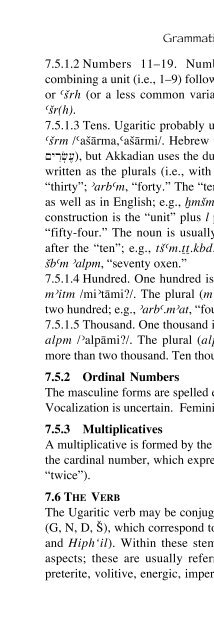A Primer on Ugaritic: Language, Culture, and Literature - enenuru
A Primer on Ugaritic: Language, Culture, and Literature - enenuru
A Primer on Ugaritic: Language, Culture, and Literature - enenuru
You also want an ePaper? Increase the reach of your titles
YUMPU automatically turns print PDFs into web optimized ePapers that Google loves.
Grammatical Précis 165<br />
7.5.1.2 Numbers 11–19. Numbers 11–19 are expressed by<br />
combining a unit (i.e., 1–9) followed by the number “ten,” either {sûr<br />
or {sûrh (or a less comm<strong>on</strong> variant, {sûrt). Eleven, however, is {sût<br />
{sûr(h).<br />
7.5.1.3 Tens. <strong>Ugaritic</strong> probably uses a dual to express twenty, i.e.,<br />
{sûrm /{asûaœrma,{asûaœrmi/. Hebrew uses the plural for “twenty” (i.e.,<br />
MyîrVcRo), but Akkadian uses the dual (i.e., esûraœ). Thirty to ninety are<br />
written as the plurals (i.e., with -m)ofthe base form: e.g., tltm,<br />
“thirty”; }arb{m, “forty.” The “ten” precedes the unit as in Hebrew<br />
as well as in English; e.g., h˙msûm.}arb{, “fifty-four.” An alternative<br />
c<strong>on</strong>structi<strong>on</strong> is the “unit” plus l plus the “ten”; e.g., }arb{.l.h˙msûm,<br />
“fifty-four.” The noun is usually, but not always, in the singular<br />
after the “ten”; e.g., tsû{m.tt.kbd.sûkl, “ninety-six heavy shekels”;<br />
sûb{m }alpm, “seventy oxen.”<br />
7.5.1.4 Hundred. One hundred is m}it. Two hundred uses the dual<br />
m}itm /mi}taœmi?/. The plural (m}at /mi}aœt/) is used for more than<br />
two hundred; e.g., }arb{.m}at, “four hundred.”<br />
7.5.1.5 Thous<strong>and</strong>. One thous<strong>and</strong> is alp. Two thous<strong>and</strong> uses the dual<br />
alpm /}alpaœmi?/. The plural (alpm /}alapuœma, -ˆäma/) is used for<br />
more than two thous<strong>and</strong>. Ten thous<strong>and</strong> or “myriad” is rbt.<br />
7.5.2 Ordinal Numbers<br />
The masculine forms are spelled exactly like the feminine numbers.<br />
Vocalizati<strong>on</strong> is uncertain. Feminine forms, where attested, add -t.<br />
7.5.3 Multiplicatives<br />
A multiplicative is formed by the additi<strong>on</strong> of the suffix -’id or -id to<br />
the cardinal number, which expresses “times” (e.g., tn}d /tinaœ-}ida/,<br />
“twice”).<br />
7.6 THE VERB<br />
The <strong>Ugaritic</strong> verb may be c<strong>on</strong>jugated into four basic derived stems<br />
(G, N, D, SÁ), which corresp<strong>on</strong>d to the Hebrew (Qal, Niph‘al, Pi‘el,<br />
<strong>and</strong> Hiph‘il). Within these stems there are least eight tenses or<br />
aspects; these are usually referred to as the perfect, imperfect,<br />
preterite, volitive, energic, imperative, infinitive, participle (active


